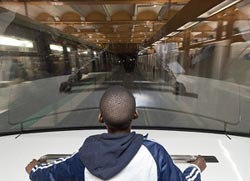Driverless Metro from the Louvre to Arc de Triomphe

Siemens is responsible for the modernization of the automation technology. The new system is more energy-efficient in operation and makes it possible to shorten the intervals between trains from 105 to 85 seconds. Line 1 trains carry up to 725,000 passengers a day, making it the most heavily traveled Metro line in Paris.
The reason Line 1 carries so many passengers is that it passes sightseeing attractions like the Louvre and the Arc de Triomphe. It would be unimaginable to even briefly interrupt service on this line, which is 17 kilometers long, so the switch to automated operation is being carried out without disrupting service.
That means installation of the control technology and the telecommunication system, fitting the rail vehicles and equipping the new control center must all take place in parallel to normal operation.
The Siemens rail automation unit's solution was to perform the work at night. At present, the old trains are being replaced, one after another. In March 2012 there were 14 driverless trains on Line 1. By early 2013 all 49 new Metro trains are to be equipped with automation technology, bringing service up to full transport capacity.
The train frequency can be flexibly adjusted as needed. Special platform screen doors ensure safety at the stations. The new trains use the Trainguard MT safety and control system, which is in service in many of the world's big cities. A subway line in New York City is also soon to be equipped with the system.
The new control system boosts energy efficiency and improves reliability: The previous system had to be left on when, for example, the trains were parked at night at a depot, in order to continually check and save data related to the vehicles' position and status. After the new system is re-started it automatically determines the position of the train by means of intelligent communication between the train and the wayside equipment.
That means it can be turned off overnight, which saves energy. And should a system go down, the train can then compute its own position on the track and also determine if another train is nearby. If the track is clear, the train automatically proceeds safely, without human hands at the controls, to the next station, where service engineers can inspect it for a possible fault. This minimizes delays due to technical malfunctions, particularly in situations where trains run very frequently.
Media Contact
More Information:
http://www.siemens.com/innovationnewsAll latest news from the category: Transportation and Logistics
This field deals with all spatial and time-related activities involved in bridging the gap between goods and people, including their restructuring. This begins with the supplier and follows each stage of the operational value chain to product delivery and concludes with product disposal and recycling.
innovations-report provides informative reports and articles on such topics as traffic telematics, toll collection, traffic management systems, route planning, high-speed rail (Transrapid), traffic infrastructures, air safety, transport technologies, transport logistics, production logistics and mobility.
Newest articles

You are What You Eat—Stanford Study Links Fiber to Anti-Cancer Gene Modulation
The Fiber Gap: A Growing Concern in American Diets Fiber is well known to be an important part of a healthy diet, yet less than 10% of Americans eat the minimum recommended…

Trust Your Gut—RNA-Protein Discovery for Better Immunity
HIRI researchers uncover control mechanisms of polysaccharide utilization in Bacteroides thetaiotaomicron. Researchers at the Helmholtz Institute for RNA-based Infection Research (HIRI) and the Julius-Maximilians-Universität (JMU) in Würzburg have identified a…

ASXL1 Mutation: The Hidden Trigger Behind Blood Cancers and Inflammation
Scientists show how a mutated gene harms red and white blood cells. LA JOLLA, CA—Scientists at La Jolla Institute for Immunology (LJI) have discovered how a mutated gene kicks off…



